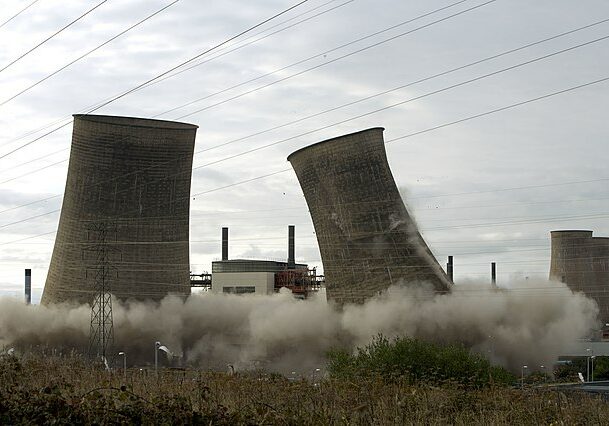Decommissioning U.S. power stations

See NRC Information Digest (2021-2022) Appendix C, “Permanently Closed and Decommissioning US Nuclear Power Stations”
Decommissioning is the process of decontaminating and dismantling permanently closed commercial nuclear power stations. Decommissioning involves the burial of the radioactive waste including contaminated materials (concrete, metals, components, soil, water, etc.) and the long-term management of those burial sites to contain the spread of radioactive contamination back to the surface and into water resources.
Decommissioning includes the radiological remediation of the reactor site within the original exclusionary fence line so that the site can be released for either unrestricted use or restricted use and the termination of the license.
Prior to reactor operations, the operator of the nuclear power plant is required to establish or obtain a financial mechanism such as a trust fund or other guarantees to ensure there will be sufficient money to pay for the ultimate decommissioning of the nuclear facility.
Decommissioning begins with the defueling of the reactor vessel and transfer of the irradiated nuclear fuel for storage underwater in the onsite “spent fuel” storage pond for an adequate cooling period of one to three years. After that period, all of the irradiated fuel previously generated and cooled is transferred into dry cask storage canisters and hauled out of the reactor building onto an onsite Independent Spent Fuel Storage Installation (ISFSI) indefinitely.
Public health and safety advocates are concerned that the present decommissioning process of nuclear power stations essentially deregulates the oversight of US Nuclear Regulatory Commission (NRC) regulations while extremely hazardous nuclear materials are still present onsite. For example, the licensed operator is allowed to choose a decommissioning plan without a formal public hearing process or even the formal approval by the Commission itself. Despite the continued onsite presence of extremely radioactive and thermally hot high-level radioactive waste, the operator is allowed to exempt the facility from offsite emergency planning. This could potentially affect public health and the safety of surrounding communities in the event of a nuclear waste cask failure which is too often cited as an “incredible event.” Once the irradiated nuclear fuel is transferred into independent dry storage casks, operators are allowed to significantly downgrade onsite security. For example, site security forces are no longer tested by live NRC force-on-force drills. The risk of radiological sabotage remains a security concern given the indefinite onsite presence of hundreds of tons of high-level radioactive waste now stored in dry storage canisters that in most cases are closely congregated on open tarmacs.
The current decommissioning options are:
SAFSTOR: According to the NRC, “A method of decommissioning in which a nuclear facility is placed and maintained in a condition that allows the facility to be safely stored and subsequently decontaminated (deferred decontamination) to levels that permit release for unrestricted use.” SAFSTOR allows for an operator to maintain the facility “cold and dark” deferring all activity so long as the ultimate decontamination, dismantlement and site remediation is promised to be completed within 60 years of closure.
DECON: “Under DECON (immediate dismantling), soon after the nuclear facility closes, equipment, structures, and portions of the facility containing radioactive contaminants are removed or decontaminated to a level that permits release of the property and termination of the NRC license.” The licensee is allowed to combine the SAFSTOR and DECON options for varying periods of time.
ENTOMB “Under ENTOMB, radioactive contaminants are permanently encased on site in structurally sound material such as concrete. The facility is maintained and monitored until the radioactivity decays to a level permitting restricted release of the property. To date, no NRC-licensed facilities have requested this option.”
Decommissioning US reactors also provides a critical opportunity for aged materials in closed reactors (base metals, weld materials, concrete, electric cable and jacketing, etc.) to be “strategically harvested” from safety-related systems, structures and components and studied by laboratory analysis. This can help determine the synergistic effects of aging caused by decades in an extreme operational environment of radiation, heat, pressure, corrosion and vibration.
Most of the nation’s reactors are now operating with licenses extensions from 40- to 60-years. More reactors are proceeding through operating license extensions from 60- to 80-year time frames. The need to study the destructive effects of many known and still to develop operational degradation mechanisms during decommissioning is now recognized as scientifically linked to the NRC’s safety review process as necessary to validate and approve increasingly extreme operating license extensions. These studies have also identified many “critical technical knowledge gaps” regarding the operational reliability during these extensions. Still, the NRC is not requiring reactor operators to conduct such “autopsies” during decommissioning to harvest the observable and measurable science of material degradation as necessary to ensure the safe operations during increasingly extreme extended operations of nuclear power plants.
Support Beyond Nuclear
Help to ensure a safer, greener and more just world for all

